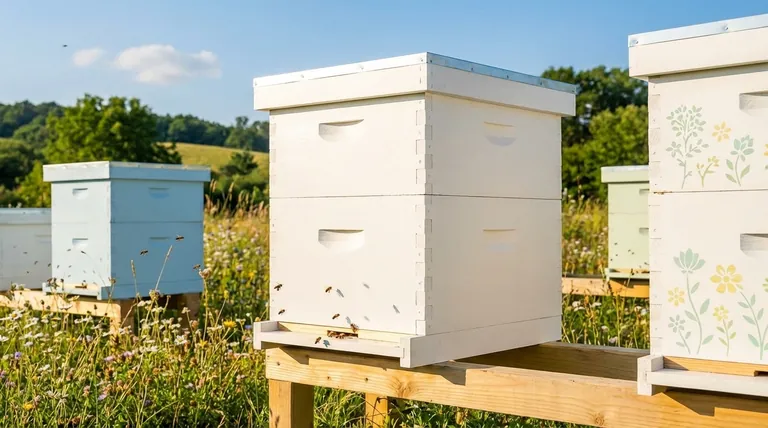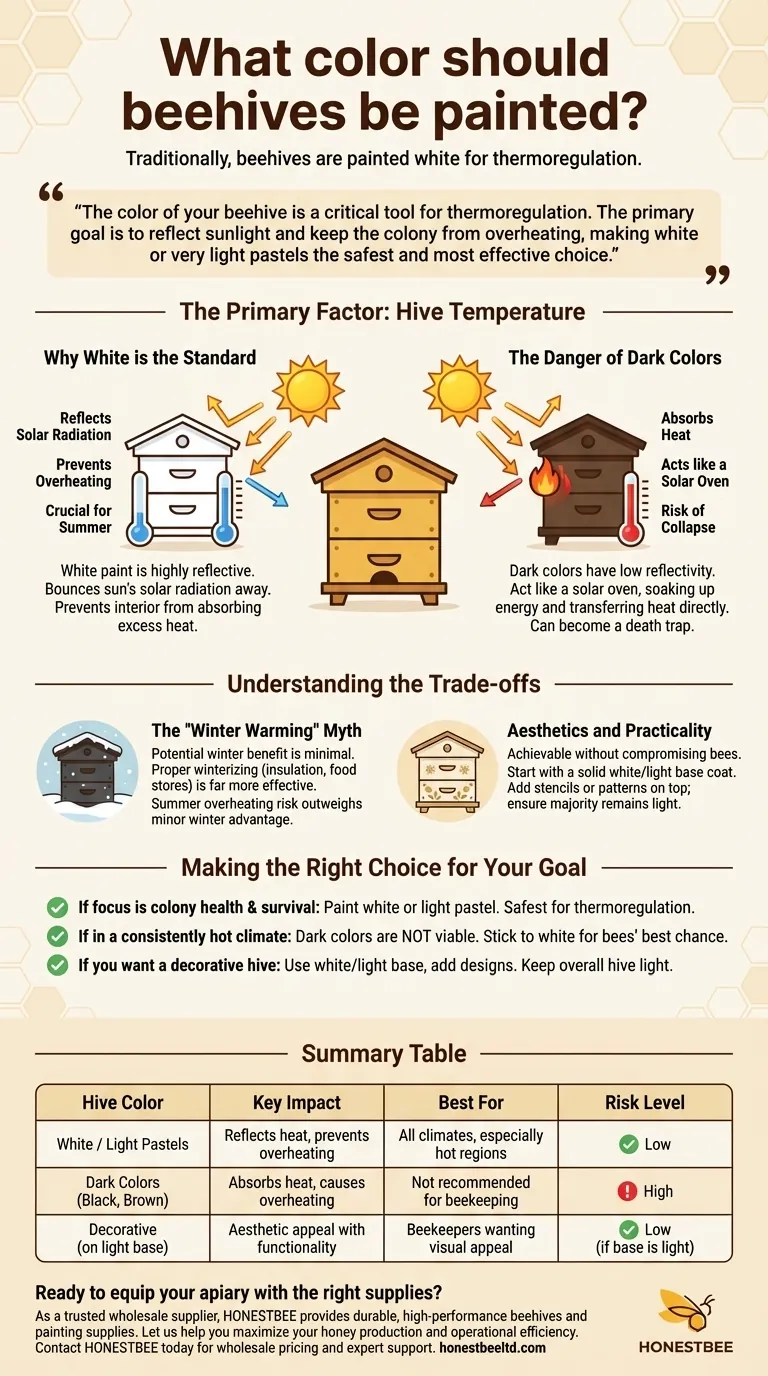Traditionally, beehives are painted white. This choice is not merely aesthetic; it is a functional decision rooted in managing the hive's internal temperature. While you can use other light colors, dark paints should be avoided, especially in climates with high summer heat.
The color of your beehive is a critical tool for thermoregulation. The primary goal is to reflect sunlight and keep the colony from overheating, making white or very light pastels the safest and most effective choice.

The Primary Factor: Hive Temperature
The health and productivity of a bee colony are directly tied to its ability to maintain a stable internal environment. Hive color plays a surprising role in this delicate balance.
Why White is the Standard
White paint is highly reflective. It bounces the sun's solar radiation away from the hive box, preventing the interior from absorbing excess heat.
This is crucial during hot summer months. An overheated hive forces the bees to expend significant energy and water on cooling efforts—such as fanning their wings and evaporative cooling—instead of foraging and raising brood.
In extreme cases, high temperatures can melt the wax comb, causing a catastrophic structural collapse that can destroy the colony and the honey harvest.
The Danger of Dark Colors
Dark colors, such as black, dark brown, or deep green, have low reflectivity and high absorption. They act like a solar oven, soaking up the sun's energy and transferring it directly into the hive.
In a hot climate, a dark-colored hive can quickly become a death trap. Even in more moderate regions, the added heat stress can weaken the colony, making it more susceptible to disease and pests.
Understanding the Trade-offs
While the science points heavily toward light colors, it's important to understand the full context of your decision.
The "Winter Warming" Myth
Some beekeepers speculate that a darker hive might help warm the colony during winter by absorbing more solar radiation.
While there is a kernel of truth to this, the potential benefit is minimal compared to the risks. Proper winterizing—such as using insulation, hive wraps, and ensuring adequate food stores—is far more effective for winter survival than hive color. The risk of lethal summer overheating almost always outweighs any minor winter advantage.
Aesthetics and Practicality
Many beekeepers want hives that are both functional and visually appealing. This is entirely achievable without compromising the bees' well-being.
If you wish to add decorative elements, start with a solid primer and a base coat of white or very light-colored exterior latex paint. You can then add stencils, patterns, or artistic designs on top. The key is to ensure the majority of the hive's surface area remains light and reflective.
Making the Right Choice for Your Goal
Base your decision on your local climate and primary objective for the hive.
- If your primary focus is colony health and survival: Paint your hives white or a very light pastel color. This is the safest, most effective choice for thermoregulation.
- If you live in a consistently hot climate: Using dark colors is not a viable option. Stick exclusively to white to give your bees the best chance of thriving.
- If you want a decorative hive: Use a white or light-colored base coat and add creative designs, ensuring the overall hive remains predominantly light to reflect heat.
Ultimately, choosing your hive color is one of your first acts as a steward for your bees' welfare.
Summary Table:
| Hive Color | Key Impact | Best For | Risk Level |
|---|---|---|---|
| White / Light Pastels | Reflects heat, prevents overheating | All climates, especially hot regions | Low |
| Dark Colors (Black, Brown) | Absorbs heat, causes overheating | Not recommended for beekeeping | High |
| Decorative (on light base) | Aesthetic appeal with functionality | Beekeepers wanting visual appeal | Low (if base is light) |
Ready to equip your apiary with the right supplies for a thriving colony?
As a trusted wholesale supplier to commercial apiaries and beekeeping equipment distributors, HONESTBEE provides durable, high-performance beehives and painting supplies designed for optimal colony health. Let us help you maximize your honey production and operational efficiency.
Contact HONESTBEE today for wholesale pricing and expert support.
Visual Guide

Related Products
- Langstroth Bee Hives Bee Keeping Box for Beginners Beekeeping
- Australian Langstroth Beehive Boxes for Beekeeping Wholesales
- HONESTBEE Professional Long Handled Hive Tool with Precision Cutting Blade
- Langstroth Honey Bee Box Hive Boxes for Different Depths
- Professional Insulated Plastic Bee Hives
People Also Ask
- Why might a beginner be advised to start with a Langstroth hive? Unlock a Supportive Beekeeping Ecosystem
- Should a beginner try a different type of hive? Start with a Langstroth for a solid foundation.
- What is the best type of bee hive for beginners? Start with the Proven Langstroth Standard
- What basic equipment is needed to start beekeeping? Your Essential Guide to a Confident Start
- How does the ease of access differ between 8-frame and 10-frame hives? Choose the Right Hive for Your Body



















